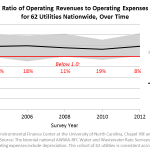Stacey Isaac Berahzer is a Senior Project Director for the Environmental Finance Center at the University of North Carolina, and works from a satellite office in Georgia.
Water rate increases can get even more controversial when there is the perception that the related increase in revenue is going to fund government activities other than water service.
With the economic downturn, local governments are having a harder time balancing their budgets and the temptation to draw from utility funds becomes harder to resist. Stories are popping up in the press, such as objections over a 59% (utility) rate increase over a 13-year period, in order to hold millage rates steady in one local government. Several factors play into whether this is an unusually high rate of increase. Inflation is one important factor. In the last ten years, the Consumer Price Index (CPI) measure of inflation rose by more than 25%. The power of compounding involved with annual rate increases over the 13 years is also an important consideration. But, if we compared this increase to, say about 2,000 utilities from six states across the country, would the 59% be an outlier? Continue reading







